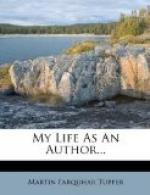The 1833 journal is Welsh; and, inter alia, I therein drew and I now record that recently destroyed and more recently restored Druidical movement, the Buckstone: “A solid mass of rock, not of living adamant but of dead pudding-stone, seemingly ‘by subtle magic poised’ on the brow of a steep and high hill, wooded with oaks: the top of this mass of rock is an area of fifty-four feet, its base being four, and the height twelve. It was once a logan stone, but now has no rocking properties; though most perilously poised on the side of a slope, and certainly, if in part a work of nature, it must have been helped by art, seeing the mere action of the atmosphere never could have so exactly chiselled away all but the centre of gravity. The secret of the Druids, in this instance at least, was in leaving a large mass behind, which as a lever counteracted the preponderance of the rock.” I drew on the spot two exact views of it, taken to scale,—whereof this is one,—now of some curious value, since its intentional destruction last year by a snobbish party of mischievous idiots. (However, I see by the papers that, at a cost of L500, it has been replaced.) Let this touch suffice as to my then growing predilection for Druidism, since expanded by me into several essays find pamphlets, touching on that strange topic, the numerous rude stone monuments from Arabia to Mona.
[Illustration]
The 1834 journal regards Scotland,—a country I have since visited several times, including the Orkneys and Shetlands, and the voyage round from Thurso via Cape Wrath to the Hebrides; whereof, perhaps, more anon. For a specimen page of this let me give what follows; the locality is near Inverness and the Caledonian Canal: “We now bent our steps toward Craig Phadrick, two miles north. This is the site of one of the celebrated vitrified forts, concerning the creation of which there has been so much learned discussion. And verily there is room, for there is mystery: I will detail what we saw. On the summit of a steep hill of conglomerate rock we could trace very clearly a double oblong enclosure of eighty yards by twenty, with entrances east and west, a space of five yards being between the two oblongs. The mounds were outwardly of turf, but under a thin skin of this was a thick continuous wall of molten stone, granite, gneiss, and sandstone, bubbling together in a hotchpot! The existence of these forts (occurring frequently on the heights and of various shapes) is attempted to be explained by divers theories. One man tells us they were beacons; but, first, what an enormous one is here, one hundred and twenty-four feet by sixty of blazing wood, timber being scarce too! next, they sometimes occur in low situations from which a flame could scarcely be seen; thirdly, common wood fire will not melt granite. Another pundit says they are volcanic. O wondrous volcano to spout oblong concentric areas of stone walls! Perhaps the best explanation is that the




